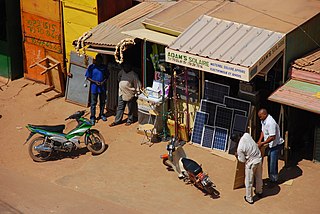Energy in Botswana is a growing industry with tremendous potential. However almost all Botswana's electricity is generated from coal. [1] No petroleum reserves have been identified and all petroleum products are imported refined, mostly from South Africa. There is extensive woody biomass from 3 to 10t / hectare.
Recently, the country has taken a large interest in renewable energy sources and has completed a comprehensive strategy that may attract investors in the wind, solar and biomass renewable energy industries. [2] Botswana's power stations include Morupule Power Stations B (600 MW), and A (132 MW), [3] Orapa Power Station (90 MW) and Phakalane Power Station (1.3 MW).
The International Renewable Energy Agency (IRENA) undertook an evaluation of the national energy sector in 2021 and found that Botswana could meet 15% of its energy needs in 2030 from its indigenous solar, wind, and bioenergy resources. [4] [5]
Solar insolation is one of the highest levels in the world, but until recently there were no reports of significant use of solar energy. As of September 2012, the first solar power generation plant in the country has been opened.
The Botswana Renewable Energy Conference was held 11–12 August 2014. [6] The Sustainable Development Goals were cited for development of renewable energy through "green and environmentally sound technologies" at the 5th plenary meeting, 70th Session of the United Nations General Assembly: the Sustainable Development Summit 2015. [7]

Renewable energy is energy from renewable natural resources that are replenished on a human timescale. Using renewable energy technologies helps with climate change mitigation, energy security, and also has some economic benefits. Commonly used renewable energy types include solar energy, wind power, hydropower, bioenergy and geothermal power. Renewable energy installations can be large or small. They are suited for urban as well as rural areas. Renewable energy is often deployed together with further electrification. This has several benefits: electricity can move heat and vehicles efficiently, and is clean at the point of consumption. Variable renewable energy sources are those that have a fluctuating nature, such as wind power and solar power. In contrast, controllable renewable energy sources include dammed hydroelectricity, bioenergy, or geothermal power.

Renewable energy commercialization involves the deployment of three generations of renewable energy technologies dating back more than 100 years. First-generation technologies, which are already mature and economically competitive, include biomass, hydroelectricity, geothermal power and heat. Second-generation technologies are market-ready and are being deployed at the present time; they include solar heating, photovoltaics, wind power, solar thermal power stations, and modern forms of bioenergy. Third-generation technologies require continued R&D efforts in order to make large contributions on a global scale and include advanced biomass gasification, hot-dry-rock geothermal power, and ocean energy. In 2019, nearly 75% of new installed electricity generation capacity used renewable energy and the International Energy Agency (IEA) has predicted that by 2025, renewable capacity will meet 35% of global power generation.

As of 2018, renewable energy accounted for 79% of the domestically produced electricity used in Brazil.
For solar power, South Asia has the ideal combination of both high solar insolation and a high density of potential customers.

Renewable energy in developing countries is an increasingly used alternative to fossil fuel energy, as these countries scale up their energy supplies and address energy poverty. Renewable energy technology was once seen as unaffordable for developing countries. However, since 2015, investment in non-hydro renewable energy has been higher in developing countries than in developed countries, and comprised 54% of global renewable energy investment in 2019. The International Energy Agency forecasts that renewable energy will provide the majority of energy supply growth through 2030 in Africa and Central and South America, and 42% of supply growth in China.

India is the world's 4th largest consumer of electricity and the world's 3rd largest renewable energy producer with 40% of energy capacity installed in the year 2022 coming from renewable sources. Ernst & Young's (EY) 2021 Renewable Energy Country Attractiveness Index (RECAI) ranked India 3rd behind USA and China. In FY2023-24, India is planning to issue 50 GW tenders for wind, solar and hybrid projects. India has committed for a goal of 500 GW renewable energy capacity by 2030. In line with this commitment, India's installed renewable energy capacity has been experiencing a steady upward trend. From 94.4 GW in 2021, the capacity has gone up to 119.1 GW in 2023 as of Q4.
Under its commitment to the EU renewable energy directive of 2009, France has a target of producing 23% of its total energy needs from renewable energy by 2020. This figure breaks down to renewable energy providing 33% of energy used in the heating and cooling sector, 27% of the electricity sector and 10.5% in the transport sector. By the end of 2014, 14.3% of France's total energy requirements came from renewable energy, a rise from 9.6% in 2005.
Despite its high potential for wind energy generation, wind power in Kenya currently contributes only about 16 percent of the country's total electrical power. However, its share in energy production is increasing. Kenya Vision 2030 aims to generate 2,036 MW of wind power by 2030. To accomplish this goal, Kenya is developing numerous wind power generation centers and continues to rely on the nation's three major wind farms: the Lake Turkana Wind Power Station, the Kipeto Wind Power Station, and the Ngong Hills Wind Farm. While these wind power stations are beneficial to help offset fossil fuel usage and increase overall energy supply reliability in Kenya, project developments have also negatively impacted some indigenous communities and the parts of the environment surrounding the wind farms.

Most of Kenya's electricity is generated by renewable energy sources. Access to reliable, affordable, and sustainable energy is one of the 17 main goals of the United Nations’ Sustainable Development Goals. Development of the energy sector is also critical to help Kenya achieve the goals in Kenya Vision 2030 to become a newly industrializing, middle-income country. With an installed power capacity of 2,819 MW, Kenya currently generates 826 MW hydroelectric power, 828 geothermal power, 749 MW thermal power, 331 MW wind power, and the rest from solar and biomass sources. Kenya is the largest geothermal energy producer in Africa and also has the largest wind farm on the continent. In March 2011, Kenya opened Africa's first carbon exchange to promote investments in renewable energy projects. Kenya has also been selected as a pilot country under the Scaling-Up Renewable Energy Programmes in Low Income Countries Programme to increase deployment of renewable energy solutions in low-income countries. Despite significant strides in renewable energy development, about a quarter of the Kenyan population still lacks access to electricity, necessitating policy changes to diversify the energy generation mix and promote public-private partnerships for financing renewable energy projects.

Ethiopia generates most of its electricity from renewable energy, mainly hydropower.

Renewable energy in Mexico contributes to 26 percent of electricity generation in Mexico. As of 2009, electricity generation from renewable energy comes from biomass, hydro power, geothermal, solar power and wind. There is a long term effort established to increase the use of renewable energy sources. The amount of geothermal energy used and harvested, places Mexico as number four in the world.

Renewable energy in Bangladesh refers to the use of renewable energy to generate electricity in Bangladesh. The current renewable energy comes from biogas that is originated from biomass, hydro power, solar and wind.

The International Renewable Energy Agency (IRENA) is an intergovernmental organization mandated to facilitate cooperation, advance knowledge, and promote the adoption and sustainable use of renewable energy. It is the first international organisation to focus exclusively on renewable energy, addressing needs in both industrialised and developing countries. It was founded in 2009 and its statute entered into force on 8 July 2010. The agency is headquartered in Masdar City, Abu Dhabi. The Director-General of IRENA is Francesco La Camera, a national of Italy. IRENA is an official United Nations observer.
Renewable energy in Thailand is a developing sector that addresses the country’s present high rate of carbon emissions. Several policies, such as the Thirteenth Plan or the Alternative Energy Development Plan, set future goals for increasing the capacity of renewable energy and reduce the reliance of nonrenewable energy. The major sources of renewable energy in Thailand are hydro power, solar power, wind power, and biomass, with biomass currently accounting for the majority of production. Thailand’s growth is hoped to lead to renewable energy cost reduction and increased investment.
Renewable energy in Chile is classified as Conventional and Non Conventional Renewable Energy (NCRE), and includes biomass, hydro-power, geothermal, wind and solar among other energy sources. Usually, when referring to Renewable Energy in Chile, it will be the Non Conventional kind.

Nepal is a country enclosed by land, situated between China and India. It has a total area of 147,181 square kilometers and a population of 29.16 million. It has a small economy, with a GDP of $33.66 billion in 2020, amounting to about 1% of South Asia and 0.04% of the World's GDP.
Myanmar had a total primary energy supply (TPES) of 16.57 Mtoe in 2013. Electricity consumption was 8.71 TWh. 65% of the primary energy supply consists of biomass energy, used almost exclusively (97%) in the residential sector. Myanmar’s energy consumption per capita is one of the lowest in Southeast Asia due to the low electrification rate and a widespread poverty. An estimated 65% of the population is not connected to the national grid. Energy consumption is growing rapidly, however, with an average annual growth rate of 3.3% from 2000 to 2007.

Renewable energy in South Africa is energy generated in South Africa from renewable resources, those that naturally replenish themselves—such as sunlight, wind, tides, waves, rain, biomass, and geothermal heat. Renewable energy focuses on four core areas: electricity generation, air and water heating/cooling, transportation, and rural energy services. The energy sector in South Africa is an important component of global energy regimes due to the country's innovation and advances in renewable energy. South Africa's greenhouse gas (GHG) emissions is ranked as moderate and its per capita emission rate is higher than the global average. Energy demand within the country is expected to rise steadily and double by 2025.
Zambia is potentially self-sufficient in sources of electricity, coal, biomass and renewable energy. The only energy source where the country is not self-sufficient is petroleum energy. Many of the sources of energy where the country is self-sufficient are largely unexploited. As of 2017, the country's electricity generating capacity stood at 1,901 megawatts.
As of 2021, there was little renewable energy in Belarus, but a lot of potential. 7% of primary energy in Belarus was from renewables in 2019, mostly biofuels. As there is a lot of district heating more renewables could be integrated into that, but this is hindered by fossil fuel subsidies.